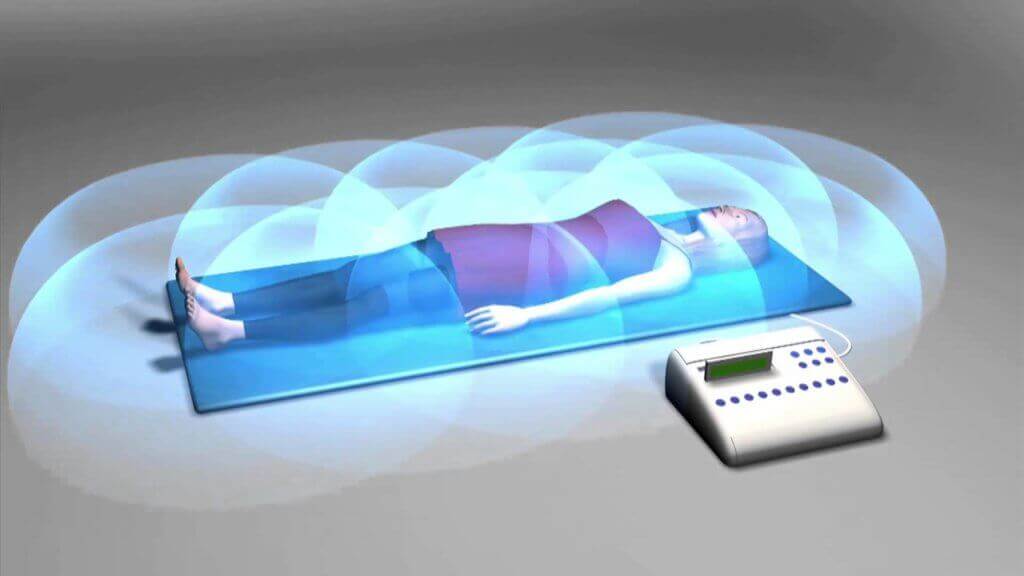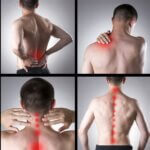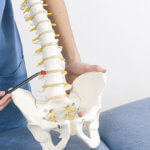What is PEMF?
PEMF stands for Pulsed Electro Magnetic Field therapy; using this particular process involves directing powerful, pulsed energy waves toward damaged or injured areas of the patient’s body. These waves painlessly and quickly pass through the cells in the damaged region, increasing the spin of the electrons contained within them as a result.
It is this amplified electron spinning which restores the cell’s potential (its energy), regulating its volume at the same time. And, unlike some other forms of CAM, this positive cellular effect lasts for as many as four days after the treatment session has ended. With that, PEMF therapy is: The induction of electricity into the cells to help stimulate or promote healing.
How PEMF works
Perhaps the easiest way to understand PEMF is to think in terms of each cell in your body as if it were a little battery. Like with any battery, sometimes your cells become tired and worn, whether due to age, stress, overuse, or damage, making it more difficult for them to fight off any type of potentially damaging force or illness.
Through PEMF therapy, your batteries (i.e. your cells) essentially become recharged. The energy supplied via PEMF waves gives them the energy they need to ward off whatever is threatening them, whether it’s a trauma or disease-based threat. This makes it easier for your body to restore its health naturally, simply by using the electrical currents and impulses that are already interacting within and throughout their cells. In essence, high-powered PEMF is like a “battery re-charger” for your depleted cells.
PEMF and NASA
This caused Goodwin to conclude that, “As is clearly demonstrated in the human body, the bioelectric, biochemical process of electrical nerve stimulation is a documented reality.” In other words, it works and it works very well.
- The Use of Complementary and Alternative Medicine in the United States. NCCIH. (2011). NCCIH. Retrieved 13 October 2016 https://nccih.nih.gov/research/statistics/2007/camsurvey_fs1.htm
- Goodwin, Thomas J. (2003). Physiological and Molecular Genetic Effects of Time-Varying Electromagnetic Fields on Human Neuronal Cells. Lyndson B. Johnson Space Center.
The history of PEMF: Thousands of years in the making
Pulsed electromagnetic field (PEMF) therapy isn’t typically as well-known as other forms of treatment such as chiropractic, massage, and physical therapy. Therefore, many people assume that it’s a relatively new remedy, leaving it wide open for speculation when it comes to its positive effects. However, the truth is, PEMF has actually been used to help people live a healthier life for quite a long time.
Thousands of years to be exact.
The use of magnetic therapy can actually be found as early as 2000 B.C., which is when Chinese book, The Yellow Emperor’s Book of Internal Medicine, noted that “magnetic stones” were used for various health issues. 1
Centuries later, during the Middle Ages, use of these types of stones was again recorded, this time referring to them as “lodestones” which were placed upon the patient’s body in an effort to achieve greater health. Then, in the late 1800s, science increased our understanding of electrons and electro-magnetism, prompting healthcare professionals to consider using magnetism and electricity for a number of different ailments, ranging from an inability to sleep to actual physical convulsions.
In fact, magnetic therapy was deemed so powerful, magnet-based products such as boots, girdles, and caps were sold through the mail. Fast-forwarding briefly to more recent times, Thomas F. Valone’s 2003 presentation to the Whole Person Healing Conference & Tesla Energy Science Conference shed some light on PEMF’s early beginnings even more. 2
Specifically, Valone shared how it was Nikola Tesla who would majorly impact PEMF’s use—forever.
Nikola Tesla and PEMF
Valone said that it was two years short of the 20th century when Tesla reportedly addressed the American Electro-Therapeutic Association, telling its members that “ One of the early observed and remarkable features of the high frequency currents, and one which was chiefly of interest to the physician, was their apparent harmlessness which made it possible to pass relatively great amounts of electrical energy through the body of a person without causing pain or serious discomfort.”
Tesla made this assertion after having used coils as big as three-foot in diameter to treat ailments without making any type of physical contact with their bodies. And it is because of this breakthrough device and its related findings that magnetic field strength today is measured in Tesla (T). While this was all new and extremely hopeful information, especially for that period of time, it wouldn’t be until more than two decades later that PEMF as we know it today would begin to really take form.
A therapy takes form
In his presentation, Valone went onto say that it was 1922 when Alexander Gurvich, a Russian doctor, and his wife discovered that our body’s cells can communicate certain bits of information with each other—even if they are physically separated by a plate of glass.
Three years later, this concept was taken one step further when Georges Lakhovsky shared his ideology and theories that the reinforcement of cell oscillation with radio waves increased their ability to fight off damage or disease. It did this by making them stronger and more resilient, Lakhovsky ascertained. Over the course of the next several decades, many researchers—Royal Raymond Rife, Antoine Priore, Robert Becker, and Abraham Liboff, to name a few—would each identify and research various pieces of information which, together helped create PEMF as we know it today.
PEMF today
Although electromagnetic therapy techniques essentially started with Tesla’s three-foot coils, engaging in PEMF therapy today is simpler on the patient and doctor alike. However, if it weren’t for the ideas, curiosities, and ahead-of-their time findings of individuals such as Tesla, Gurvich, and Lakhovsky, PEMF therapy would not be where it is today.
Who knows? It may not even be at all.
- History of pulsed electromagnetic field. pemf.com.(2016). Pemf.com. Retrieved October 2016, www.pemf.com/en/history.html
- Bioelectromagnetic Healing – Integrity ResearchInstitute. (2016). Integrityresearchinstitute.org. Retrieved October 2016.www.integrityresearchinstitute.org/Bioenergy/BEMsHealing.html
Conditions clinical PEMF helps treat
Some treatment devices offer relief limited in nature.
Take dental braces, for instance.
These are devices designed for one reason and one reason only: to align and straighten your teeth, thereby improving the health of your mouth. To apply them anywhere else on your body would serve no beneficial purpose whatsoever (not to mention, probably look more than a little foolish).
The same is true with foot orthotics. They were created to correct foot and leg defects due to trauma or disease, or any type of issue that occurs as a result of bio mechanical inadequacies. However, if you wear them on your hands, this would do you absolutely no good.
Head and Neck
The American Osteopathic Association reports neck pain is the third most common chronic pain, afflicting more than one in four Americans at any given time.1
Fortunately, PEMF can often help with issues in this area of the body. Case in point: one study in Rheumatology International found that subjects with cervical osteoarthritis had pain levels, which “decreased significantly” after PEMF. 2
Study participants also reported improvements in disability and range of motion, especially when compared to a control group who received sham PEMF treatments.
Back
PEMF also helps treat numerous back-related issues, even if they occur post-surgery. In fact, one study in Current Orthopaedic Practice found that PEMF prompted increased bone formation for 85 percent of the participants, all of whom endured failed posterior lumbar inter body fusion. 3
Seventy-seven percent achieved body-to-body fusion after being treated with PEMF. The researchers involved in this study also pointed out that PEMF “required no hospitalization, reduced morbidity, and avoided the risks associated with surgical intervention”—three more reasons why this remedy is a preferred treatment choice.
Joints
When it comes to joints, arthritis is often one of the biggest concerns. However, PEMF helps not only with arthritic symptoms, but also potentially the cause as one piece of research in the Indian Journal of Experimental Biology found that “the use of PEMF for arthritis cure has conclusively shown that PEMF not only alleviates the pain in the arthritis condition but it also affords chondroprotection, exerts anti-inflammatory action and helps in bone remodeling.” 4
As Benjamin Franklin once said, “An ounce of prevention is worth a pound of cure.”
Click to Tweet
Chronic Body Conditions
PEMF is even helpful when it comes to chronic conditions that affect your entire body.
For instance, one study published in Pain Research and Management found that, after seven days of twice-daily PEMF treatments, participants who struggled with fibromyalgia responded positively to the pulsed electromagnetic therapy, reporting less pain after treatment sessions. 5
Another study, this one in Chinese Medical Journal, concluded that “low frequency PEMFs relieves the pain of primary osteoporosis quickly and efficiently, enhances bone formation and increases BMD [bone mineral density] of secondary osteoporosis.” 6
PEMF has also shown positive effects with Alzheimer’s disease, Lou Gehrig’s, cancer, heart disease, depression, diabetes, endometriosis, epilepsy, headaches, glaucoma, hepatitis, kidney problems, lung disease, lupus, multiple sclerosis, pancreatitis, Parkinson’s, sexual disorders, sleep disorders, spinal cord injury, stroke, Tourette’s, ulcers, urinary problems, and more.
- Chronic Neck Pain . (2016). Osteopathic.org. Retrieved October 2016, osteopathic.org/osteopathic-health/about-your-health/healthconditions-library/pain/Pages/chronic-neck-pain.aspx.
- Sutbeyaz, S., Sezer, N., & Koseoglu, B. (2005).The effect of pulsed electromagnetic fields in the treatment of cervical osteoarthritis: a randomized, double-blind, sham-controlled trial. Rheumatology International, 26(4), 320-324.doi:10.1007/s00296-005-0600-3
- Treatment of Failed Posterior Lumbar InterbodyFusion (PLIF)…: Clinical Orthopaedics and RelatedResearch. (2016). LWW. Retrieved October 2016, journals.lww.com/corr/Abstract/1985/03000/Treatment_of_Failed_Posterior_Lumbar_Interbody.16.aspx
- Ganesan, K. Low frequency pulsed electromagnetic field, a viable alternative therapy for arthritis. Indian Journal of Experimental Biology. Vol. 47, December 2009, pg. 939-948
- Alex W Thomas, S. (2007). A randomized, double blind, placebo-controlled clinical trial using a low-frequency magnetic field in the treatment of musculoskeletal chronic pain. Pain Research &Management : The Journal Of The Canadian Pain Society, 12(4), 249. Retrieved from https://www.ncbi.nlm.nih.gov/pmc/articles/PMC2670735/
- Huang, Li-qun et al. Clinical update of pulsed electromagnetic fields on osteoporosis. Chinese Medical Journal. 2008; 121(20):2095-2009.
Is PEMF safe?
When it comes to choosing a treatment option, one of the first questions most ask is: “Is it safe?” And, rightfully so.
According to the World Health Organization (WHO), “Patient safety is a serious global public health issue.”1
They back this statement by reporting that even hospitalized patients are at risk, with one out of every ten harmed while in what is supposed to be one of the safest medical environments. It only goes to reason then that safety is also a major concern and consideration for patients who are interested in PEMF therapy. So what’s the answer to the question of whether or not PEMF is safe? If you answer this question based on research alone, then PEMF is in fact a safe treatment remedy.
A safe treatment option
For instance, in the May-June 2008 issue of The Spine Journal, a clinical study was published involving 323 patients with a compressed cervical nerve root and symptomatic radiculopathy, leading into anterior cervical discectomy and fusion.2
Post-surgery, approximately half of the participants engaged in PEMF therapy while the other half served as a control. After evaluating the patients’ statuses at one, two, three, six, and twelve-month intervals, the researchers concluded that, “There were no differences in the incidence of adverse events in the two groups, indicating that the use of PEMF stimulation is safe in this clinical setting.” It’s important to note that, although PEMF was deemed safe in this study, there was still one major difference between the group who participated in this therapy and the group that did not.
And that’s in the positive effects that PEMF offered.
Notably, the researchers found that the PEMF group had an 83.6 percent fusion rate at six months’ post-op compared to the control group’s 68.6 percent. Additionally, fusion rates for the PEMF group were still higher at the 12-month point, with a 92.8 percent success rate for their group versus only 86.7 percent for the control.
Safety matters
Another study, in Bio-electromagnetics, looked at 11 different trials involving PEMF to determine its level of therapeutic effect as well as whether or not it was safe. Some of these studies involved PEMF’s effects on osteoarthritis, fibromyalgia, or pain perception, while the rest focused on how PEMF impacted skin ulcers, fatigue related to multiple sclerosis, heart rate variability, and overall well-being.3
While the researchers ultimately recommended that more research be conducted on this particular treatment method to be able to clearly say that it is effective for a variety of different health conditions, they also noted that“ Acute adverse effects have not been reported.” This was after reviewing 11 PEMF studies in total, each of which had anywhere from 12 to 71 participants.
The list could go on and on as there are several more studies that have focused on the same thing, too many to mention to be honest. However, there is one common theme among all of them and that is that PEMF is a safe treatment option. That makes this one concern that can be crossed off your list.






